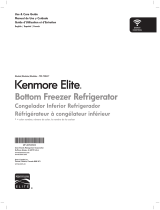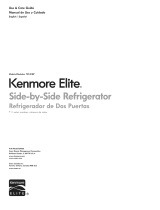
• DO NOT install the refrigerator in a damp place or place
where it may come in contact with water. Wet and/or
deteriorated insulation of the internal electrical parts may
cause electric shock or fire.
• DO NOT store volatile or flammable substances in the
refrigerator. Storing benzene, thinner, alcohol, ether, LP
gas, and other such products may cause explosions.
• DO NOT disassemble or repair the refrigerator by
yourself. You may run the risk of fire, appliance
malfunctions, and/or personal injury. Call your nearest
service center for help from a qualified service
technician.
• Unplug the refrigerator before changing the interior light.
Changing the light while the refrigerator is plugged in
may cause electric shock.
The refrigerator must be safely grounded. ALWAYS
make sure that you have grounded the refrigerator
before attempting to investigate or repair any part of the
appliance. Power leakages can cause severe electric
shock.
NEVER use gas pipes, telephone lines, or other
potential lightning attractors as an electrical ground.
Improper use of the grounding plug can result in a risk
of electric shock. If it is necessary to use an extension
cord to power the refrigerator, use only a 3-wire
extension cord that has a 3-blade ground plug and
a 3-slot receptacle that will accept the plug on the
appliance. The marked rating of the extension cord
should be AC 115V/120V, 15A, or more. Additionally,
if a grounding adapter is used, make sure the receptacle
box is also fully grounded.
• Use good judgment when filling the refrigerator with food
and drinks. In an overfull refrigerator, heavy, fragile,
bulky, or breakable items may fall out and cause
personal injury and/or damage to surrounding objects.
• DO NOT put bottles or glass containers in the freezer.
When the contents freeze and then expand, the glass
may break and cause personal injury or leave
dangerous glass shards in the freezer.
• If the electrical wall socket is loose, do not insert the
power plug. There is a risk of electric shock or fire. Have
the plug looked at by a licensed electrician.
• NEVER unplug your refrigerator by pulling on the power
cord.
- Always grip the power plug firmly and pull straight out
from the outlet. Yanking or pulling on the power cord
may cause a short circuit, fire, and/or electric shock.
- A damaged power cord must be replaced by the
manufacturer, a certified service agent, or qualified
service personnel.
• DO NOT store articles on the top of the appliance.
When you open or close the door, the articles may
fall and cause personal injury and/or damage to
surrounding objects.
• DO NOT store pharmaceutical products, scientific
materials, and temperature-sensitive products in the
refrigerator. Products that require exact temperature
controls should not be stored in the refrigerator.
• DO NOT allow children to climb, stand, or hang on
shelves and handles of the refrigerator. DO NOT sit on
the freezer door. DO NOT allow children to climb into
the freezer. They could damage the refrigerator and/or
seriously injure themselves.
If you notice a chemical or burning plastic smell or see
smoke, unplug the refrigerator immediately and contact
your Sears Service Center.
After your refrigerator is in operation, do not touch the
cold surfaces in the freezer compartment. Particularly
when hands are damp or wet, skin may adhere to these
extremely cold surfaces. Skin may stick to the surface
and you may get frostbite.
DO NOT put your hands under the appliance. Any sharp
edges may cause personal injury.
NEVER put fingers or other objects into the water
dispenser hole or ice chute. It may cause personal injury
and/or material damage.
If the refrigerator will not be used for a long period of
time (for example, over several months), unplug the
power from the wall. Over time, deterioration in the
power cord insulation may cause fire.
DO NOT use a wet or damp cloth when cleaning plug.
Remove any dust or foreign matter from the power plug
pins. A dirty power plug can increase the risk of fire.
If the refrigerator is disconnected from the power supply,
you should wait for at least five minutes before plugging
it back in.
• DO NOT place the refrigerator directly in sunlight.
• The appliance must be positioned for easy access to the
power source.






























